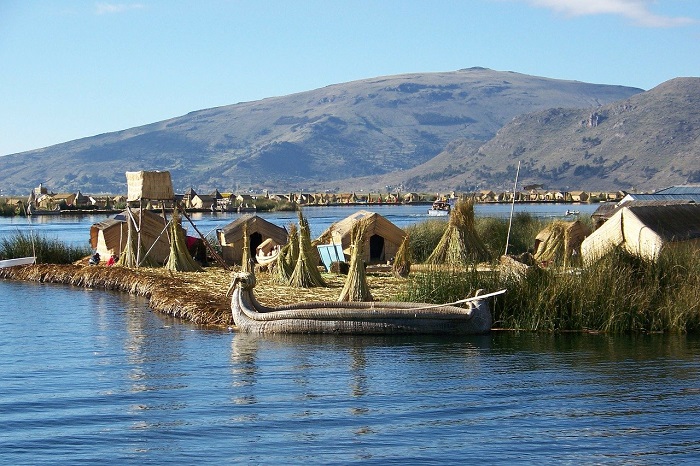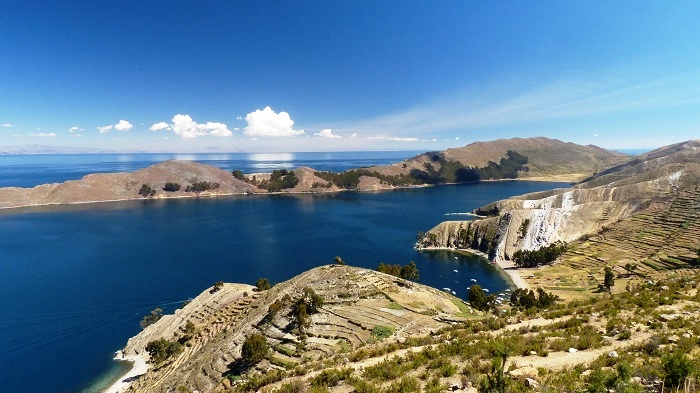Lake Titicaca is one of the coolest and most cultural places in Peru, lying at 12,500 feet above sea level in the Andes Mountains of South America. Set on the border of Bolivia and Peru, it's the largest lake in South America by volume of water and the highest navigable lake in the world. The total area of Lake Titicaca is 8,562 square kilometers, of which 56% belongs to Peru and 44% belongs to Bolivia. The eastern part of the lake is located in the Bolivian La Paz Department and the western part lies within the Puno Region of Peru. The lake has an average depth of 108 meters. It is the world’s highest lake navigable to large vessels, for many years the largest vessel afloat on the lake was the 2,200-ton, 79-metre SS Ollanta, a steamship built in England in 1931. Today vessels make regular crossings from Puno, on the Peruvian shore, to the small Bolivian port of Guaqui. Lake Titicaca is called “The Birthplace of the Incas”, and “The Birthplace of the Sun”. More than 25 rivers and many glaciers empty into Lake Titicaca. A team of international archaeologists found the ruins of an underwater temple in 2000, ranging from 1,000 to 1,500 years old.
See Also:-Lake Hillier, Australia - The Pink Lake
Image Source - Pixabay
The lake has many reasons for being so special, one is that the lake has forty-one islands, some of which are densely populated. The major islands are Uros, Amantani, Taquile, Isla del Sol, Isla de la Luna, and Suriki. One of the largest islands of the lake is "Isla del Sol" ("Island of the Sun"), which lies just off the tip of the Copacabana Peninsula in Bolivia. The sun god was believed to have been born here as according to the religion of the Incas. There are more than 180 ruins remain on the island and most of these date to the Inca period around the 15th century AD. Among the ruins on the island are the Sacred Rock, a labyrinth-like building called Chicana, Kasa Pata, and Pilco Kaima. Another island Isla de la Luna (Spanish for "island of the moon") is situated east from the bigger Isla del Sol. Both these islands belong to the La Paz Department of Bolivia.
See Also:-Jellyfish Lake, Palau - The Home of Millions of jellyfish
Image Source - Pixabay
The most notable feature of the lake is the Uroz Islands towards the Peruvian side which are the famous artificial floating islands of the Uros people, which are made of totora reeds, a thick buoyant reed that grows abundantly in the shallows of Lake Titicaca. Not only this, People's homes, boats, and crafts are also built out of the same reed. Inhabited by a pre-Incan population, called Uros, an indigenous people of Peru and Bolivia, and descendants of a much more ancient culture still continue to live on these floating islands. Many of the islands measure about 15 by 15 m, and the largest are roughly half the size of a football field. About 14 km from the shore, most of the Uros Islands were located near the middle of the lake; however, in 1986, a major storm devastated the islands, resulting in many Uros rebuilt closer to shore. These floating islands have now become one of Peru's tourist attractions.
See Also:-Gruner See, Styria - A Park That Turns Into a Lake in Summer
Image Source - Pixabay
Lake Titicaca is home to more than 530 aquatic species, as well as large populations of water birds. Threatened species found here include the enormous Titicaca water frog and the Titicaca grebe. About 90% of the fish species found in the basin are endemic which are not found anywhere else. Lake Titicaca also has reeds and other aquatic vegetation that is found over a large area in the Lake. Totora reeds grow in water shallower than 3 meters, less frequently to 5.5 meters.
See Also:-Lake Natron - Turns Animals to Stone
Image Source - Pixabay
See Also:-Lake Hillier, Australia - The Pink Lake
Image Source - Pixabay
The lake has many reasons for being so special, one is that the lake has forty-one islands, some of which are densely populated. The major islands are Uros, Amantani, Taquile, Isla del Sol, Isla de la Luna, and Suriki. One of the largest islands of the lake is "Isla del Sol" ("Island of the Sun"), which lies just off the tip of the Copacabana Peninsula in Bolivia. The sun god was believed to have been born here as according to the religion of the Incas. There are more than 180 ruins remain on the island and most of these date to the Inca period around the 15th century AD. Among the ruins on the island are the Sacred Rock, a labyrinth-like building called Chicana, Kasa Pata, and Pilco Kaima. Another island Isla de la Luna (Spanish for "island of the moon") is situated east from the bigger Isla del Sol. Both these islands belong to the La Paz Department of Bolivia.
See Also:-Jellyfish Lake, Palau - The Home of Millions of jellyfish
Image Source - Pixabay
The most notable feature of the lake is the Uroz Islands towards the Peruvian side which are the famous artificial floating islands of the Uros people, which are made of totora reeds, a thick buoyant reed that grows abundantly in the shallows of Lake Titicaca. Not only this, People's homes, boats, and crafts are also built out of the same reed. Inhabited by a pre-Incan population, called Uros, an indigenous people of Peru and Bolivia, and descendants of a much more ancient culture still continue to live on these floating islands. Many of the islands measure about 15 by 15 m, and the largest are roughly half the size of a football field. About 14 km from the shore, most of the Uros Islands were located near the middle of the lake; however, in 1986, a major storm devastated the islands, resulting in many Uros rebuilt closer to shore. These floating islands have now become one of Peru's tourist attractions.
See Also:-Gruner See, Styria - A Park That Turns Into a Lake in Summer
Image Source - Pixabay
Lake Titicaca is home to more than 530 aquatic species, as well as large populations of water birds. Threatened species found here include the enormous Titicaca water frog and the Titicaca grebe. About 90% of the fish species found in the basin are endemic which are not found anywhere else. Lake Titicaca also has reeds and other aquatic vegetation that is found over a large area in the Lake. Totora reeds grow in water shallower than 3 meters, less frequently to 5.5 meters.
See Also:-Lake Natron - Turns Animals to Stone
Image Source - Pixabay
See Also:-Lake Bled - The Natural Beauty of Slovenia
Lake Titicaca is one of the most visited tourist destinations in Peru and a visit to the Uros islands is a unique opportunity for tourists to get to know the customs of Incas and modern Uros people.
Lake Titicaca is one of the most visited tourist destinations in Peru and a visit to the Uros islands is a unique opportunity for tourists to get to know the customs of Incas and modern Uros people.
















0 comments:
Post a Comment